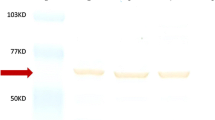Abstract
Objective
CYP2C9 is a polymorphic enzyme, and CYP2C9*3 is associated with decreased metabolic activity. In addition to the impaired metabolism, we investigated whether the CYP2C9*3 exhibited altered inhibitory susceptibility compared with CYP2C9*1.
Method
In the present study, CYP2C9.1 and CYP2C9.3 were expressed in yeast. Using typical CYP2C9 substrates (diclofenac, tolbutamide and S-warfarin) and a potent CYP2C9 inhibitor (nicardipine), the K i values for nicardipine on the three metabolisms in CYP2C9*1 and CYP2C9*3 were determined.
Result
The ratios of K i (CYP2C9*3) /K i (CYP2C9*1) on tolbutamide, diclofenac and S-warfarin metabolisms were 1.2, 3.1 and 0.8, respectively.
Conclusion
In conclusion, there are no significant differences in the inhibitory susceptibility between the two CYP2C9 enzymes.
Similar content being viewed by others
References
Miners JO, Birkett DJ (1998) Cytochrome P4502C9: an enzyme of major importance in human drug metabolism. Br J Clin Pharmacol 45:525–538
Ingelman-Sundberg M, Oscarson M, McLellan RA (1999) Polymorphic human cytochrome P450 enzymes: an opportunity for individualized drug treatment. Trends Pharmacol Sci 20:342–349
Kidd RS, Straughn AB, Meyer MC, Blaisdell J, Goldstein JA, Dalton JT (1999) Pharmacokinetics of chlorpheniramine, phenytoin, glipizide and nifedipine in an individual homozygous for the CYP2C9*3 allele. Pharmacogenetics 9:71–80
Hanatani T, Fukuda T, Ikeda M, Imaoka S, Hiroi T, Funae Y, Azuma J (2001) CYP2C9*3 influences the metabolism and the drug-interaction of candesartan in vitro. Pharmacogenomics J 1:288–292
Takanashi K, Tainaka H, Kobayashi K, Yasumori T, Hosakawa M, Chiba K (2000) CYP2C9 Ile359 and Leu359 variants: enzyme kinetic study with seven substrates. Pharmacogenetics 10:95–104
Klose TS, Ibeanu GC, Ghanayem BI, Pedersen LG, Li L, Hall SD, Goldstein JA (1998) Identification of residues 286 and 289 as critical for conferring substrate specificity of human CYP2C9 for diclofenac and ibuprofen. Arch Biochem Biophys 357:240–248
Ieiri I, Tainaka H, Morita T, Hadama A, Mamiya K, Hayashibara M, Ninomiya H, Ohmori S, Kitada M, Tashiro N, Higuchi S, Otsubo K (2000) Catalytic activity of three variants (Ile, Leu, and Thr) at amino acid residue 359 in human CYP2C9 gene and simultaneous detection using single-strand conformation polymorphism analysis. Ther Drug Monit 22:237–244
Katoh M, Nakajima M, Shimada N, Yamazaki H, Yokoi T (2000) Inhibition of human cytochrome P450 enzymes by 1,4-dihydropyridine calcium antagonists: prediction of in vivo drug-drug interactions. Eur J Clin Pharmacol 55:843–852
Acknowledgements
This work was supported a grant (no. 99–2) from the Organization for Pharmaceutical Safety and Research. A part of this study was supported by a Grant-in-Aid for Scientific Research (nos. 12204072, 12470525 and 13204052) from the Ministry of Education, Culture, Sports, Science and Technology of Japan.
Author information
Authors and Affiliations
Corresponding author
Rights and permissions
About this article
Cite this article
Hanatani, T., Fukuda, T., Onishi, S. et al. No major difference in inhibitory susceptibility between CYP2C9.1 and CYP2C9.3. Eur J Clin Pharmacol 59, 233–235 (2003). https://doi.org/10.1007/s00228-003-0603-5
Received:
Accepted:
Published:
Issue Date:
DOI: https://doi.org/10.1007/s00228-003-0603-5




